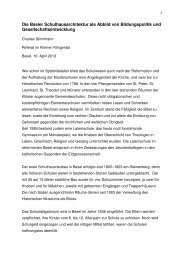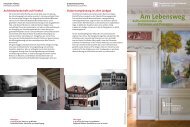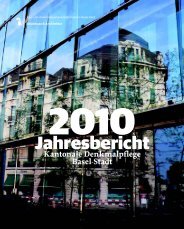Spalentor (Spalen Gate) - Denkmalpflege
Spalentor (Spalen Gate) - Denkmalpflege
Spalentor (Spalen Gate) - Denkmalpflege
Create successful ePaper yourself
Turn your PDF publications into a flip-book with our unique Google optimized e-Paper software.
Matthäus Merian, Map of the city of Basel, 1617. Detail with <strong><strong>Spalen</strong>tor</strong><br />
(<strong>Spalen</strong> <strong>Gate</strong>) and barriers as well as two squat corner towers.<br />
Archives of Kantonale <strong>Denkmalpflege</strong> Basel-Stadt<br />
The sculptures<br />
Above the gateway: a city of Basel coatofarms on an escutcheon<br />
held aloft by two rampant lions dating from c. 1400;<br />
a statue of the Virgin cast as the Queen of Heaven with<br />
crown and sceptre and in her arms the infant Jesus. The<br />
clouds below the crescent moon at her feet are populated<br />
by five angelic minstrels holding a fiddle, organ (portable),<br />
dulcimer, lute and shawm. The Virgin is flanked by two<br />
Old Testament prophets, identified variously as Isaiah and<br />
Micah or as Enoch and Elijah (?), c. 1420 (replicas).<br />
Inside the gateway: keystone of the vaulting with<br />
angelic figure, c. 1400. On the gatehouse: numerous corbel<br />
figures, all of which are replicas dating from 1984, based<br />
loosely on the originals now in the Historical Museum. On<br />
the merlons: two warriors in full armour holding escutcheons,<br />
1473/74 (replicas).<br />
The façade facing into the city features one of Basel’s<br />
famous “Basler Dybli” (Basle Dove) letterboxes designed by<br />
Melchior Berri in 1844.<br />
The gates<br />
The portcullis is a grille made of oak beams whose pointed<br />
ends are capped with iron. It was raised and lowered inside<br />
two grooves with a winch.<br />
Use was also made of a system of twelve oak beams that<br />
could be lowered individually (like those installed in the<br />
St. JohannsTor in 1582). These were suspended by ropes<br />
and rings at the top, while their pointed ends at the bottom<br />
were again capped with iron.<br />
July 2003<br />
— 2 —<br />
The large oak door, whose hinges rest inside huge, drumlike<br />
bearings inside the passageway, used to be closed at<br />
sundown every day until the law requiring this was<br />
repealed in 1859. Latecomers could still slip into the city<br />
by way of the little “manhole” known as the “eye of the<br />
needle”.<br />
The side door in the gatehouse originally opened onto<br />
the ditch, which was eventually converted into plots of<br />
land that became very popular as allotment gardens. There<br />
were vineyards (each with its own little shed) in front of<br />
the <strong><strong>Spalen</strong>tor</strong> right up to the midnineteenth century.<br />
View of <strong><strong>Spalen</strong>tor</strong> (<strong>Spalen</strong> <strong>Gate</strong>) from <strong>Spalen</strong>graben.<br />
Photo A. Ballié, Archives of Kantonale <strong>Denkmalpflege</strong> Basel-Stadt














